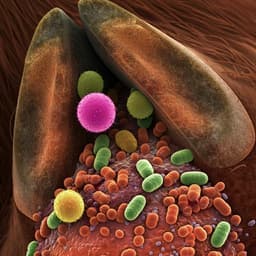
Biology
Regulatory fine-tuning of *mcr-1* increases bacterial fitness and stabilises antibiotic resistance in agricultural settings
L. Ogunlana, D. Kaur, et al.
Discover how regulatory evolution fine-tunes *mcr-1* expression in *E. coli*, allowing for high resistance against colistin with low fitness costs. This study by Lois Ogunlana, Divjot Kaur, Liam P. Shaw, Pramod Jangir, Timothy Walsh, Stephan Uphoff, and R. C. MacLean explores the stability of antibiotic resistance in pig farms after colistin was banned.
~3 min • Beginner • English
Introduction
The study addresses why antibiotic resistance persists despite reduced antibiotic use, focusing on the mobile colistin resistance gene mcr-1 in Escherichia coli. Resistance often imposes fitness costs, so reduced antibiotic consumption should select against resistance. However, real-world interventions frequently produce only modest declines in resistance prevalence. The authors hypothesise that compensatory evolution stabilises colistin resistance by reducing the fitness costs of mcr-1 while maintaining resistance. They examine regulatory polymorphisms upstream of mcr-1, assess their effects on fitness and resistance, and analyse genomic epidemiological data from agricultural settings in China following a national ban on colistin as an animal growth promoter.
Literature Review
The authors review concepts that resistance typically entails fitness costs and can be maintained via compensatory evolution that offsets these costs without reducing resistance. Direct clinical examples of compensatory stabilization are rare, except in Mycobacterium tuberculosis. Alternative mechanisms like co-selection and horizontal transfer via conjugative plasmids can also stabilise resistance. mcr-1 spread rapidly across one-health settings, driven by colistin use in agriculture, mainly via conjugative plasmids (IncX4, IncI2, IncHI2) and an initial ISApI1 composite transposon. Expression of mcr-1 alters outer membrane LPS, creating pleiotropic costs (growth rate reductions up to ~30%). After China’s 2017 colistin ban, mcr-1 prevalence declined but more slowly than expected given reported costs, suggesting low residual fitness cost or compensatory changes.
Methodology
- Genetic constructs: Cloned mcr-1 with its native 75 bp upstream regulatory region into the low-copy pSEVA121 vector (~4–6 copies/cell). Generated eight regulatory variants with single nucleotide polymorphisms in the −10 promoter box or Shine–Dalgarno (SD) site (PV1–PV4, SDV1–SDV4). Created a catalytically inactivated MCR-1 mutant (T285A) under the wild-type regulatory sequence as control. All constructs sequence-verified and transformed into E. coli MG1655. pSEVA121 stability assessed.
- Chromosomal integration: Inserted mcr-1 with wild-type regulatory sequence into the MG1655 chromosome (replacing lacZ) via lambda red recombineering. Verified by blue-white screening and sequencing.
- Growth/fitness assays: Measured exponential growth rates in colistin-free medium (LB/MHB) with repeated experiments across days, correcting for day effects. Conducted qPCR-tagged competitive fitness assays co-culturing regulatory variant strains versus the WT-regulated mcr-1 strain across a colistin gradient (0, 0.375, 0.75, 1.5 µg/ml) for 20 h; quantified relative plasmid abundances by variant-specific qPCR; computed relative fitness and analysed with ANOVA including variant and colistin concentration effects.
- Resistance phenotyping: Determined MIC and estimated IC50 for colistin by broth microdilution across 0–8 µg/ml, fitting dose–response curves.
- Expression and activity: Quantified mcr-1 transcript levels by one-step RT-qPCR, normalising to trfA (pSEVA121) and accounting for primer efficiencies. Assessed MCR-1 activity via cell surface charge using FITC–PLL binding assays (reduced binding indicates reduced negative surface charge from lipid A modification).
- In silico predictions: Evaluated effects of promoter and SD variants on transcription/translation potential.
- Genomics and phylogenetics: Re-analysed 688 mcr-1-positive E. coli short-read datasets from China (2016–2018) across human, animal (pigs), food, and environment (Shen dataset; PRJNA593695). De novo assembly (SPAdes), detection of plasmid replicons (ABRicate), and classification of upstream regulatory sequences using custom scripts (mcroni v1.0.4). Examined contig lengths and presence/absence of ISApI1. Focused on IncX4 plasmids: mapped reads from 220 IncX4-bearing contigs to reference IncX4 plasmid KU761327.1, masked repetitive regions, built a core SNP phylogeny (FastTree), and assigned regulatory variants to clades.
- Epidemiology/statistics: Combined mcr-1 prevalence data on pig farms (2016–2018; 66 farms; 684–1575 pigs/year) with frequencies of regulatory variants from sequencing to estimate variant carriage frequencies and changes over time. Used one-sided two-sample tests for equality of proportions (without continuity correction) to compare pre- vs post-ban frequencies. Applied Dunnett’s tests, Bonferroni-corrected pairwise comparisons, linear regressions correlating fitness with IC50 and expression, and ANOVAs for fitness data.
Key Findings
- Fitness costs and regulatory variants: Seven of eight promoter/SD variants had increased growth rates relative to the WT-regulated mcr-1 strain in colistin-free media, indicating reduced fitness costs. Catalytic inactivation (T285A) of MCR-1 largely eliminated the cost, implicating MCR-1 activity as the main cost driver.
- Reduced expression/activity: Regulatory variants generally reduced mcr-1 transcript abundance and partially alleviated the reduction in cell surface charge seen with WT regulation, consistent with decreased MCR-1 expression/activity.
- Resistance maintained or increased: MICs/IC50s showed equal or higher colistin resistance for most variants; 6/8 variants increased IC50 relative to WT, one slightly decreased.
- Competitive fitness: Across colistin gradients, regulatory variants exhibited higher fitness than the WT strain both with and without colistin (variant main effect p=1.84e-14). Fitness benefits peaked at intermediate colistin; no significant variant*colistin interaction (p=0.983). A single estimated fitness per variant showed all variants > WT.
- Correlations: Fitness in drug-free media correlated positively with resistance (IC50) (F(1,7)=12.96, p=0.009, r^2=0.65) and negatively with expression level (indicating higher fitness at optimised lower expression) (F(1,7)=14.76, p=0.006, r^2=0.68). Variation in measured MCR-1 activity among regulatory variants did not predict fitness.
- Chromosomal integration: Moving mcr-1 from plasmid to chromosome (single copy) increased growth rate and colistin MIC relative to plasmid expression, consistent with benefits of reduced expression.
- Genomic epidemiology: WT regulatory sequences were enriched on contigs lacking plasmid replicons and on very short contigs (<3 kb), consistent with intact ISApI1 composite transposons and mobile mcr-1 cassettes; regulatory variants were associated with longer contigs and lack of ISApI1, indicating ‘fossilised’ cassettes on plasmids. Strong association between IncX4 and PV3: 194/220 (88.2%) IncX4-containing contigs had PV3; 194/201 (96.5%) PV3-containing contigs had IncX4. IncX4 plasmids with PV2 and PV3 formed separate phylogenetic clades, implying at least two independent regulatory fine-tuning events. PV3 IncX4 plasmids were found across 71 E. coli sequence types, including prevalent livestock-associated ST10.
- Impact of colistin ban on farms: Despite a 90% reduction in colistin use, regulatory variants increased in proportion relative to WT on pig farms from 2016 to 2018 (p=0.037). PV3 increased relative to WT (p=0.033) and showed more stable carriage in pigs post-ban, suggesting higher stability of low-cost/high-resistance alleles. Overall mcr-1 prevalence in pigs declined (e.g., from 34% to 5.1% in surveillance studies), but less rapidly than expected from high costs reported elsewhere, consistent with compensatory regulatory evolution and plasmid dissemination.
Discussion
The findings support the hypothesis that compensatory evolution stabilises mcr-1-mediated colistin resistance by fine-tuning gene expression. Mutations in promoter or SD regions reduce mcr-1 expression to levels that minimise the pleiotropic fitness costs of MCR-1 activity while maintaining or even increasing colistin resistance. This challenges the common expectation that reducing expression trades off with resistance; instead, optimal intermediate expression improved both fitness and resistance, likely by avoiding deleterious membrane alterations at high MCR-1 levels. Conjugative plasmids, particularly IncX4, disseminated these low-cost/high-resistance alleles across a broad host strain diversity, facilitating persistence of resistance at the species level even when antibiotic pressure was reduced. In agricultural settings following colistin withdrawal, regulatory variants—especially PV3—were relatively enriched and more stable than WT-regulated mcr-1, explaining the slower-than-expected decline in resistance prevalence. Together, regulatory evolution and plasmid transfer can limit the impact of antibiotic use reduction strategies, underscoring the need to account for gene-level adaptation and horizontal gene transfer in resistance management.
Conclusion
This study demonstrates that regulatory fine-tuning of mcr-1 reduces the fitness cost of colistin resistance while maintaining or increasing resistance levels, and that conjugative plasmids spread these optimised alleles across diverse E. coli lineages. This combination stabilises resistance in agricultural settings even after substantial reductions in colistin use. Practically, antibiotic use bans can still reduce overall prevalence, but compensated alleles decline more slowly, diminishing impact. Future work should elucidate the mechanistic basis for decreased resistance at high mcr-1 expression, quantify the role of chromosomal background in modulating costs, and directly test how rates of horizontal gene transfer and plasmid ecology shape the persistence of compensated resistance in One Health contexts. Integrating evolutionary trajectories of resistance genes into surveillance and modeling will improve forecasts and interventions.
Limitations
- Mechanistic uncertainty: The study did not resolve why high mcr-1 expression can reduce colistin resistance; membrane-level mechanisms are inferred but not fully delineated. - Genetic scope: While regulatory mutations upstream of mcr-1 were the focus, compensatory changes in chromosomal genes or elsewhere on plasmids could also contribute and were not comprehensively dissected. - Genomic data constraints: Reliance on short-read assemblies can fragment mcr-1 regions and complicate inference about ISApI1 presence; some variants were classified as “other” due to non-exact matches. - External validity: Experimental work used E. coli MG1655 and a specific low-copy vector; costs and benefits may vary across strains and plasmid backbones. - Epidemiological inference: Associations between variant frequencies and stability post-ban are observational; direct measures of transmission dynamics and fitness in situ were not performed.
Related Publications
Explore these studies to deepen your understanding of the subject.







